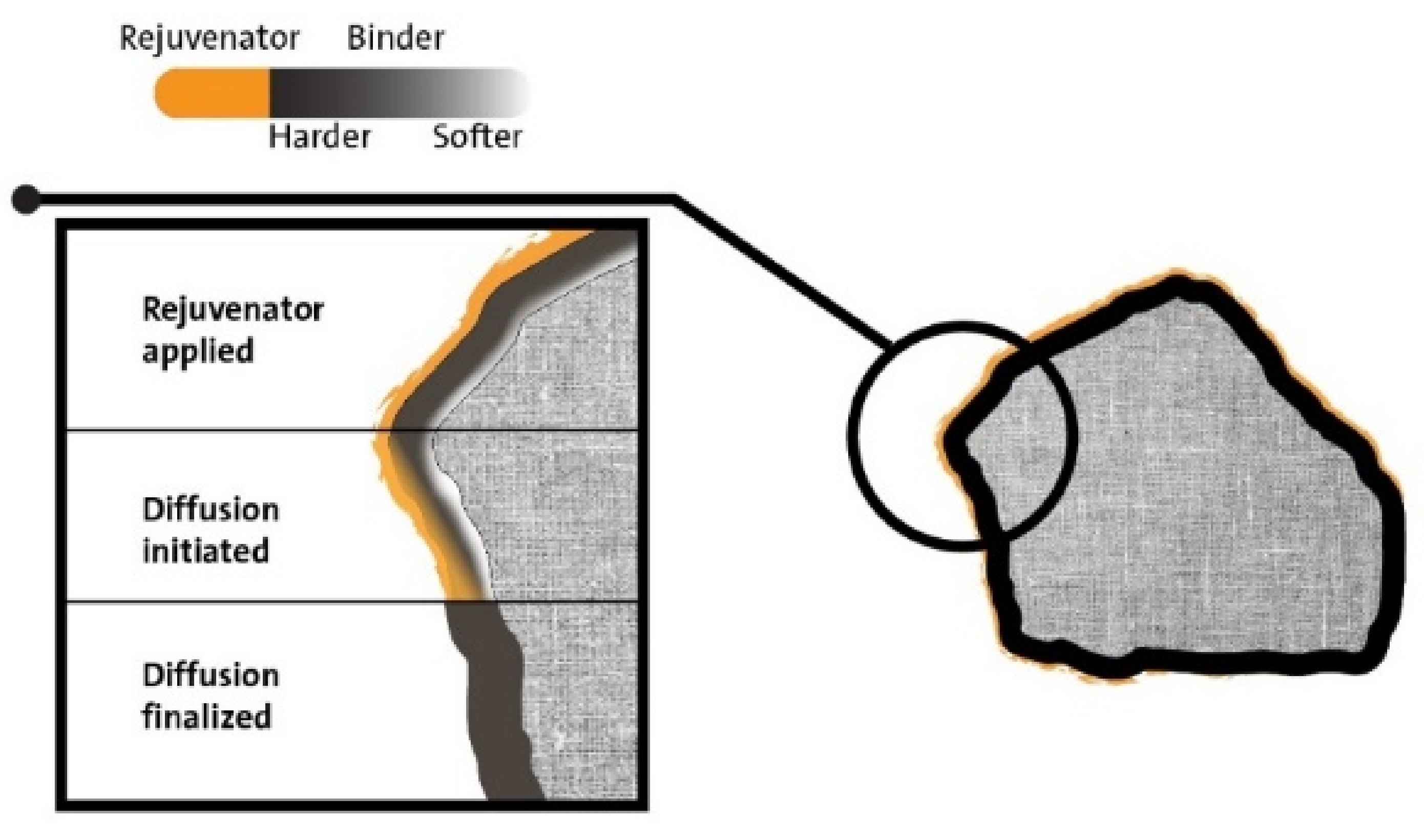A Review on the Durability of Recycled Asphalt Mixtures Embraced with Rejuvenators
Abstract
:1. Introduction
2. Classification of Rejuvenators
3. Characterisation of Rejuvenators with Recycled Asphalt
3.1. Rejuvenation of Recycled Asphalt Using Plant-Oils
3.2. Rejuvenation of Recycled Asphalt Using Refined Crude-Oils
3.3. Rejuvenation of Recycled Asphalt Using Bio-Oil Products
3.4. Rejuvenation of Recycled Asphalt Using Hybrid Rejuvenator
3.5. Rejuvenation of Recycled Asphalt Using Commercial Rejuvenators
4. Selection of Rejuvenator
- Restore viscosity, penetration, ductility, and softening point attributes.
- Improve cracking resistance without adversely affecting high-temperature performance.
- Maintain cohesion and adhesion properties close to those of VA.
- Possess acceptable resistance to ageing (close to that of VA).
- Possess adequate flow, stability, ITS, and resistance to moisture damage before and after ageing.
- Achieve a balance between stiffness and rutting resistance in the rejuvenated asphalt.
5. Conclusions
- Most rejuvenators can restore the physical properties of aged asphalt. However, high restoration capacity of these rejuvenating agents does not assure the durability of restored aged asphalt.
- In addition, some rejuvenators can be used in cold regions, but unsuitable in hot regions. Certain rejuvenators have poor resistance to moisture damage.
- In attaining a viable solution from technical and practical stances, some rejuvenating agents are not preferred due to their potential rutting damage, poor practicality, and low durability for their medium- to long-term usage.
- The negative impact of rejuvenating agents can be minimised by including additives, such as polymers, fibers, and CRM.
- The rejuvenators should possess a series of fundamental requirements in terms of performance, availability, and logistics. More importantly, these rejuvenators should have homogeneity in composition.
- Early ageing due to certain rejuvenators demands further exploration, particularly for LTA. Thus, it is compulsory to study the ageing effect on the rejuvenators before introducing them to the industry.
Author Contributions
Funding
Institutional Review Board Statement
Informed Consent Statement
Data Availability Statement
Acknowledgments
Conflicts of Interest
References
- Ahmad, J.; Yusoff, N.I.M.; Hainin, M.R.; Abd Rahman, M.Y.; Hossain, M. Investigation into hot-mix asphalt moisture-induced damage under tropical climatic conditions. Constr. Build. Mater. 2014, 50, 567–576. [Google Scholar] [CrossRef]
- Chen, M.; Leng, B.; Wu, S.; Sang, Y. Physical, chemical and rheological properties of waste edible vegetable oil rejuvenated asphalt binders. Constr. Build. Mater. 2014, 66, 286–298. [Google Scholar] [CrossRef]
- Zhang, J.; Sun, C.; Li, P.; Jiang, H.; Liang, M.; Yao, Z.; Zhang, X.; Airey, G. Effect of different viscous rejuvenators on chemical and mechanical behavior of aged and recovered bitumen from RAP. Constr. Build. Mater. 2020, 239, 117755. [Google Scholar] [CrossRef]
- Xu, M.; Zhang, Y. Study of rejuvenators dynamic diffusion behavior into aged asphalt and its effects. Constr. Build. Mater. 2020, 261, 120673. [Google Scholar] [CrossRef]
- Bilema, M.; Aman, M.Y.; Hassan, N.A.; Memon, Z.A.; Omar, H.A.; Yusoff, N.I.M.; Milad, A. Mechanical Performance of Reclaimed Asphalt Pavement Modified with Waste Frying Oil and Crumb Rubber. Materials 2021, 14, 2781. [Google Scholar]
- Ziari, H.; Moniri, A.; Bahri, P.; Saghafi, Y. The effect of rejuvenators on the aging resistance of recycled asphalt mixtures. Constr. Build. Mater. 2019, 224, 89–98. [Google Scholar] [CrossRef]
- Kandhal, P.; Mallick, R. Pavement Recycling Guidelines for State And Local Governments—Participant’s Handbook; U.S. Department of Transportation: Washington, DC, USA, 1997.
- Zahoor, M.; Nizamuddin, S.; Madapusi, S.; Giustozzi, F. Sustainable asphalt rejuvenation using waste cooking oil: A comprehensive review. J. Clean. Prod. 2020, 278, 123304. [Google Scholar] [CrossRef]
- Copeland, A. Reclaimed Asphalt Pavement in Asphalt Mixtures: State of the Practice (Publication No. FHWA-HRT-11-021); Turner-Fairbank Highway Research Center, Federal Highway Administration: McLean, VA, USA, 2011. [Google Scholar]
- Xinxin, C.; Xuejuan, C.; Boming, T.; Yuanyuan, W.; Xiaolong, L. Investigation on possibility of waste vegetable oil rejuvenating aged asphalt. Appl. Sci. 2018, 8, 765. [Google Scholar] [CrossRef] [Green Version]
- Sreedhar, S.; Coleri, E. The effect of long-term aging on fatigue cracking resistance of asphalt mixtures. Int. J. Pavement Eng. 2020, 1–13. [Google Scholar] [CrossRef]
- Kleizienė, R.; Panasenkienė, M.; Vaitkus, A. Effect of Aging on Chemical Composition and Rheological Properties of Neat and Modified Bitumen. Materials 2019, 12, 4066. [Google Scholar] [CrossRef] [Green Version]
- Zhang, Z.; Han, S.; Han, X.; Dong, S.; Yao, T. Performance changes of hot recycled asphalt mixture in different layers under coupling of multiple aging factors. Constr. Build. Mater. 2020, 269, 121343. [Google Scholar] [CrossRef]
- Ren, S.; Liu, X.; Wang, H.; Fan, W.; Erkens, S. Evaluation of rheological behaviors and anti-aging properties of recycled asphalts using low-viscosity asphalt and polymers. J. Clean. Prod. 2020, 253, 120048. [Google Scholar] [CrossRef]
- Ahmad, K.A.; Abdullah, M.E.; Hassan, N.A.; Usman, N.; Hassan, M.R.M.; Bilema, M.A.; Saeed, S.M.; Batari, A. Effect of Bio Based Rejuvenator on Mix Design, Energy Consumption and GHG Emission of High RAP Mixture. In IOP Conference Series: Earth and Environmental Science; IOP Publishing: Bristol, UK, 2018; p. 012086. [Google Scholar]
- Xie, Z.; Rizvi, H.; Purdy, C.; Ali, A.; Mehta, Y. Effect of rejuvenator types and mixing procedures on volumetric properties of asphalt mixtures with 50% RAP. Constr. Build. Mater. 2019, 218, 457–464. [Google Scholar] [CrossRef]
- Yu, X.; Zaumanis, M.; Dos Santos, S.; Poulikakos, L.D. Rheological, microscopic, and chemical characterization of the rejuvenating effect on asphalt binders. Fuel 2014, 135, 162–171. [Google Scholar] [CrossRef]
- Tran, N.H.; Taylor, A.; Willis, R. Effect of Rejuvenator on Performance Properties of HMA Mixtures with High RAP and RAS Contents; NCAT Report No. 12-05; National Center for Asphalt Technology, Auburn University: Auburn, AL, USA, 2012. [Google Scholar]
- Pan, P.; Kuang, Y.; Hu, X.; Zhang, X. A comprehensive evaluation of rejuvenator on mechanical properties, durability, and dynamic characteristics of artificially aged asphalt mixture. Materials 2018, 11, 1554. [Google Scholar] [CrossRef] [Green Version]
- Roberts, F.L.; Kandhal, P.S.; Brown, E.R.; Lee, D.-Y.; Kennedy, T.W. Hot Mix Asphalt Materials, Mixture Design and Construction; National Asphalt Pavement Association Research and Education Foundation: Lanham, MD, USA, 1991. [Google Scholar]
- Loise, V.; Caputo, P.; Porto, M.; Calandra, P.; Angelico, R.; Oliviero Rossi, C. A review on Bitumen Rejuvenation: Mechanisms, materials, methods and perspectives. Appl. Sci. 2019, 9, 4316. [Google Scholar] [CrossRef] [Green Version]
- Zaumanis, M.; Mallick, R.B.; Frank, R. 100% recycled hot mix asphalt: A review and analysis. Resour. Conserv. Recycl. 2014, 92, 230–245. [Google Scholar] [CrossRef]
- Moghaddam, T.B.; Baaj, H. The use of rejuvenating agents in production of recycled hot mix asphalt: A systematic review. Constr. Build. Mater. 2016, 114, 805–816. [Google Scholar] [CrossRef]
- Yaseen, G.; Hafeez, I. Effect of Cereclor as Rejuvenator to Enhance the Aging Resistance of Reclaimed Asphalt Pavement Binder. Materials 2020, 13, 1582. [Google Scholar] [CrossRef] [Green Version]
- Rajib, A.I.; Pahlavan, F.; Fini, E.H. Investigating Molecular-Level Factors That Affect the Durability of Restored Aged Asphalt Binder. J. Clean. Prod. 2020, 270, 122501. [Google Scholar] [CrossRef]
- Bilema, M.; Aman, M.Y.; Hassan, N.A.; Al-Saffar, Z.; Mashaan, N.S.; Memon, Z.A.; Milad, A.; Yusoff, N.I.M. Effects of Waste Frying Oil and Crumb Rubber on the Characteristics of a Reclaimed Asphalt Pavement Binder. Materials 2021, 14, 3482. [Google Scholar]
- Mohammadafzali, M.; Ali, H.; Musselman, J.A.; Sholar, G.A.; Rilko, W.A. Aging of rejuvenated asphalt binders. Adv. Mater. Sci. Eng. 2017. [Google Scholar] [CrossRef] [Green Version]
- Shen, J.; Amirkhanian, S.; Tang, B. Effects of rejuvenator on performance-based properties of rejuvenated asphalt binder and mixtures. Constr. Build. Mater. 2007, 21, 958–964. [Google Scholar] [CrossRef]
- Kaseer, F.; Martin, A.E.; Arámbula-Mercado, E. Use of recycling agents in asphalt mixtures with high recycled materials contents in the United States: A literature review. Constr. Build. Mater. 2019, 211, 974–987. [Google Scholar] [CrossRef]
- Tabatabaee, H.A.; Kurth, T.L. Analytical investigation of the impact of a novel bio-based recycling agent on the colloidal stability of aged bitumen. Road Mater. Pavement Des. 2017, 18, 131–140. [Google Scholar] [CrossRef]
- De Bock, L.; Vansteenkiste, S.; Vanelstraete, A. Categorisation and Analysis of Rejuvenators for Asphalt Recycling; Belgian Road Research Centre: Brussels, Belgium, 2020. [Google Scholar]
- Zadshir, M.; Oldham, D.J.; Hosseinnezhad, S.; Fini, E.H. Investigating bio-rejuvenation mechanisms in asphalt binder via laboratory experiments and molecular dynamics simulation. Constr. Build. Mater. 2018, 190, 392–402. [Google Scholar] [CrossRef]
- Ali, A.W.; Mehta, Y.A.; Nolan, A.; Purdy, C.; Bennert, T. Investigation of the impacts of aging and RAP percentages on effectiveness of asphalt binder rejuvenators. Constr. Build. Mater. 2016, 110, 211–217. [Google Scholar] [CrossRef]
- Elseifi, M.A.; Mohammad, L.N.; Cooper, S.B. III. Laboratory evaluation of asphalt mixtures containing sustainable technologies. Asph. Paving Technol. 2011, 227–244. [Google Scholar]
- Im, S.; Zhou, F.; Lee, R.; Scullion, T. Impacts of rejuvenators on performance and engineering properties of asphalt mixtures containing recycled materials. Constr. Build. Mater. 2014, 53, 596–603. [Google Scholar] [CrossRef]
- Kaseer, F.; Cucalon, L.G.; Arámbula-Mercado, E.; Martin, A.E.; Epps, J. Practical tools for optimizing recycled materials content and recycling agent dosage for improved short-and long-term performance of rejuvenated binder blends and mixtures. J. Assoc. Asph. Paving Technol. 2018, 87, 513–550. [Google Scholar] [CrossRef]
- Behnood, A. Application of rejuvenators to improve the rheological and mechanical properties of asphalt binders and mixtures: A review. J. Clean. Prod. 2019, 231, 171–182. [Google Scholar] [CrossRef]
- Al-Saffar, Z.H.; Yaacob, H.; Satar, M.K.I.M.; Saleem, M.K.; Lai, J.C.; Putra Jaya, R. A review on rejuvenating materials used with reclaimed hot mix asphalt. Can. J. Civ. Eng. 2021, 48, 233–249. [Google Scholar] [CrossRef]
- Cai, X.; Zhang, J.; Xu, G.; Gong, M.; Chen, X.; Yang, J. Internal aging indexes to characterize the aging behavior of two bio-rejuvenated asphalts. J. Clean. Prod. 2019, 220, 1231–1238. [Google Scholar] [CrossRef]
- Yang, X.; Mills-Beale, J.; You, Z. Chemical characterization and oxidative aging of bio-asphalt and its compatibility with petroleum asphalt. J. Clean. Prod. 2017, 142, 1837–1847. [Google Scholar] [CrossRef]
- Yin, F.; Kaseer, F.; Arámbula-Mercado, E.; Epps Martin, A. Characterising the long-term rejuvenating effectiveness of recycling agents on asphalt blends and mixtures with high RAP and RAS contents. Road Mater. Pavement Des. 2017, 18, 273–292. [Google Scholar] [CrossRef]
- Bilema, M.; Aman, M.; Hassan, N.; Abdullah, N. Investigation on Rheology and Physical Properties of Asphalt Binder Blended with Waste Cooking Oil. In IOP Conference Series: Materials Science and Engineering; IOP Publishing: Bristol, UK, 2019; p. 012045. [Google Scholar]
- Zargar, M.; Ahmadinia, E.; Asli, H.; Karim, M.R. Investigation of the possibility of using waste cooking oil as a rejuvenating agent for aged bitumen. J. Hazard. Mater. 2012, 233, 254–258. [Google Scholar] [CrossRef] [PubMed]
- El-Shorbagy, A.M.; El-Badawy, S.M.; Gabr, A.R. Investigation of waste oils as rejuvenators of aged bitumen for sustainable pavement. Constr. Build. Mater. 2019, 220, 228–237. [Google Scholar] [CrossRef]
- Zaumanis, M.; Mallick, R.B.; Poulikakos, L.; Frank, R. Influence of six rejuvenators on the performance properties of Reclaimed Asphalt Pavement (RAP) binder and 100% recycled asphalt mixtures. Constr. Build. Mater. 2014, 71, 538–550. [Google Scholar] [CrossRef]
- Cao, X.; Wang, H.; Cao, X.; Sun, W.; Zhu, H.; Tang, B. Investigation of rheological and chemical properties asphalt binder rejuvenated with waste vegetable oil. Constr. Build. Mater. 2018, 180, 455–463. [Google Scholar] [CrossRef]
- Elkashef, M.; Williams, R.C. Improving fatigue and low temperature performance of 100% RAP mixtures using a soybean-derived rejuvenator. Constr. Build. Mater. 2017, 151, 345–352. [Google Scholar] [CrossRef]
- Chen, M.; Xiao, F.; Putman, B.; Leng, B.; Wu, S. High temperature properties of rejuvenating recovered binder with rejuvenator, waste cooking and cotton seed oils. Constr. Build. Mater. 2014, 59, 10–16. [Google Scholar] [CrossRef]
- Featherstone, S. A Complete Course in Canning and Related Processes: Volume 3 Processing Procedures for Canned Food Products; Woodhead Publishing: Sawston, UK, 2015. [Google Scholar]
- Embuscado, M.E. Herbs and Spices as Antioxidants for Food Preservation. In Handbook of Antioxidants for Food Preservation; Elsevier: Amsterdam, The Netherlands, 2015; pp. 251–283. [Google Scholar]
- Murphy, B.; Horner, G.; Tarcy, D.; Bylikin, S. Oxford IB Diploma Programme: Chemistry Course Companion; Oxford University Press-Children: Oxford, UK, 2014. [Google Scholar]
- Gibson, M. Food Science and the Culinary Arts; Academic Press: Cambridge, MA, USA, 2018. [Google Scholar]
- Mirhosseini, A.F.; Tahami, S.A.; Hoff, I.; Dessouky, S.; Ho, C.-H. Performance evaluation of asphalt mixtures containing high-RAP binder content and bio-oil rejuvenator. Constr. Build. Mater. 2019, 227, 116465. [Google Scholar]
- Wan Azahar, W.N.A.; Bujang, M.; Jaya, R.P.; Hainin, M.R.; Ngadi, N.; Al Bakri, M.M.A. Performance of Waste Cooking Oil in Asphalt Binder Modification. In Key Engineering Materials; Trans Tech Publications: Freienbach, Switzerland, 2016; pp. 216–226. [Google Scholar]
- Hussein, Z.; Yaacob, H.; Idham, M.; Hassan, N.; Choy, L.; Jaya, R. Restoration of Aged Bitumen Properties Using Maltenes. In IOP Conference Series: Materials Science and Engineering; IOP Publishing: Bristol, UK, 2020; p. 012014. [Google Scholar]
- Al-Saffar, Z.H.; Yaacob, H.; Satar, M.K.I.M.; Saleem, M.K.; Jaya, R.P.; Basar, N.; Radeef, H.R.; Hassan, N.A. Effects of maltene on the attributes of reclaimed asphalt pavement: Performance optimisation. Constr. Build. Mater. 2021, 302, 124210. [Google Scholar] [CrossRef]
- Al-Saffar, Z.H.; Yaacob, H.; Mohd Satar, M.K.I.; Putra Jaya, R. The tailored traits of reclaimed asphalt pavement incorporating maltene: Performance analyses. Int. J. Pavement Eng. 2020, 1–14. [Google Scholar] [CrossRef]
- Zaumanis, M.; Mallick, R.B.; Frank, R. Evaluation of rejuvenator’s effectiveness with conventional mix testing for 100% reclaimed Asphalt pavement mixtures. Transp. Res. Rec. 2013, 2370, 17–25. [Google Scholar] [CrossRef] [Green Version]
- Wang, F.; Fang, Y.; Chen, Z.; Wei, H. Effect of Waste Engine Oil on Asphalt Reclaimed Properties. In AIP Conference Proceedings; AIP Publishing: College Park, MD, USA, 2018; p. 020012. [Google Scholar]
- Li, H.; Dong, B.; Wang, W.; Zhao, G.; Guo, P.; Ma, Q. Effect of Waste Engine Oil and Waste Cooking Oil on Performance Improvement of Aged Asphalt. Appl. Sci. 2019, 9, 1767. [Google Scholar] [CrossRef] [Green Version]
- Liu, S.; Peng, A.; Wu, J.; Zhou, S.B. Waste engine oil influences on chemical and rheological properties of different asphalt binders. Constr. Build. Mater. 2018, 191, 1210–1220. [Google Scholar] [CrossRef]
- Lin, P.-S.; Wu, T.-L.; Chang, C.-W.; Chou, B.-Y. Effects of recycling agents on aged asphalt binders and reclaimed asphalt concrete. Mater. Struct. 2011, 44, 911–921. [Google Scholar] [CrossRef]
- Farooq, M.A.; Mir, M.S.; Sharma, A. Laboratory study on use of RAP in WMA pavements using rejuvenator. Constr. Build. Mater. 2018, 168, 61–72. [Google Scholar] [CrossRef]
- Bilema, M.; Aman, Y.B.; Hassan, N.A.; Al-Saffar, Z.; Ahmad, K.; Rogo, K. Performance of Aged Asphalt Binder Treated with Various Types of Rejuvenators. Civ. Eng. J. 2021, 7, 502–517. [Google Scholar] [CrossRef]
- Borhan, M.N.; Suja, E.; Ismail, A.; Rahmat, R.A.O. Used Cylinder Oil Modified Cold—Mix Asphalt Concrete. J. Appl. Sci. 2007, 7, 3485–3491. [Google Scholar]
- Jia, X.; Huang, B.; Moore, J.A.; Zhao, S. Influence of waste engine oil on asphalt mixtures containing reclaimed asphalt pavement. J. Mater. Civ. Eng. 2015, 27, 04015042. [Google Scholar] [CrossRef]
- Zaumanis, M.; Mallick, R.B. Review of very high-content reclaimed asphalt use in plant-produced pavements: State of the art. Int. J. Pavement Eng. 2015, 16, 39–55. [Google Scholar] [CrossRef]
- Ji, J.; Yao, H.; Suo, Z.; You, Z.; Li, H.; Xu, S.; Sun, L. Effectiveness of vegetable oils as rejuvenators for aged asphalt binders. J. Mater. Civ. Eng. 2017, 29, D4016003. [Google Scholar] [CrossRef]
- Al-Saffar, Z.H.; Yaacob, H.; Satar, M.K.I.M. Performance of reclaimed asphalt pavement rejuvenated with maltene. Ph.D. Thesis, Universiti Technologi Malaysia, Skudai, Malaysia, 2021. [Google Scholar]
- Zhao, K.; Wang, Y.; Chen, L.; Li, F. Diluting or dissolving? The use of relaxation spectrum to assess rejuvenation effects in asphalt recycling. Constr. Build. Mater. 2018, 188, 143–152. [Google Scholar] [CrossRef]
- Espinoza-Luque, A.F.; Al-Qadi, I.L.; Ozer, H. Optimizing rejuvenator content in asphalt concrete to enhance its durability. Constr. Build. Mater. 2018, 179, 642–648. [Google Scholar] [CrossRef]
- Al-Saffar, Z.H.; Yaacob, H.; Satar, M.K.I.M.; Kamarudin, S.N.N.; Mahmud, M.Z.H.; Ismail, C.R.; Hassan, S.A.; Mashros, N. A review on the usage of waste engine oil with aged asphalt as a rejuvenating agent. Mater. Today Proc. 2021, 42, 2374–2380. [Google Scholar] [CrossRef]
- Wang, H.; Ma, Z.; Chen, X.; Hasan, M.R. Preparation process of bio-oil and bio-asphalt, their performance, and the application of bio-asphalt: A comprehensive review. J. Traffic Transp. Eng. 2020, 7, 137–151. [Google Scholar] [CrossRef]
- Zhang, R.; You, Z.; Wang, H.; Chen, X.; Si, C.; Peng, C. Using bio-based rejuvenator derived from waste wood to recycle old asphalt. Constr. Build. Mater. 2018, 189, 568–575. [Google Scholar] [CrossRef]
- Zhang, R.; You, Z.; Wang, H.; Ye, M.; Yap, Y.K.; Si, C. The impact of bio-oil as rejuvenator for aged asphalt binder. Constr. Build. Mater. 2019, 196, 134–143. [Google Scholar] [CrossRef]
- Kowalski, K.J.; Król, J.B.; Bańkowski, W.; Radziszewski, P.; Sarnowski, M. Thermal and fatigue evaluation of asphalt mixtures containing RAP treated with a bio-agent. Appl. Sci. 2017, 7, 216. [Google Scholar] [CrossRef] [Green Version]
- Zhu, H.; Xu, G.; Gong, M.; Yang, J. Recycling long-term-aged asphalts using bio-binder/plasticizer-based rejuvenator. Constr. Build. Mater. 2017, 147, 117–129. [Google Scholar] [CrossRef]
- Grilli, A.; Gnisci, M.I.; Bocci, M. Effect of ageing process on bitumen and rejuvenated bitumen. Constr. Build. Mater. 2017, 136, 474–481. [Google Scholar] [CrossRef]
- Peralta, J.; Williams, R.C.; Silva, H.M.; Machado, A.V.A. Recombination of Asphalt with Bio-Asphalt: Binder Formulation and Asphalt Mixes Application; Iowa State University: Ames, IA, USA, 2014. [Google Scholar]
- Tran, N.; Taylor, A.; Turner, P.; Holmes, C.; Porot, L. Effect of rejuvenator on performance characteristics of high RAP mixture. Road Mater. Pavement Des. 2017, 18, 183–208. [Google Scholar] [CrossRef]
- Cavalli, M.C.; Zaumanis, M.; Mazza, E.; Partl, M.N.; Poulikakos, L.D. Effect of ageing on the mechanical and chemical properties of binder from RAP treated with bio-based rejuvenators. Compos. Part B Eng. 2018, 141, 174–181. [Google Scholar] [CrossRef]
- Nayak, P.; Sahoo, U.C. Rheological, chemical and thermal investigations on an aged binder rejuvenated with two non-edible oils. Road Mater. Pavement Des. 2017, 18, 612–629. [Google Scholar] [CrossRef]
- Gong, M.; Yang, J.; Zhang, J.; Zhu, H.; Tong, T. Physical–chemical properties of aged asphalt rejuvenated by bio-oil derived from biodiesel residue. Constr. Build. Mater. 2016, 105, 35–45. [Google Scholar] [CrossRef]
- Mogawer, W.S.; Booshehrian, A.; Vahidi, S.; Austerman, A.J. Evaluating the effect of rejuvenators on the degree of blending and performance of high RAP, RAS, and RAP/RAS mixtures. Road Mater. Pavement Des. 2013, 14, 193–213. [Google Scholar] [CrossRef]
- Ahmed, R.B.; Hossain, K. Waste cooking oil as an asphalt rejuvenator: A state-of-the-art review. Constr. Build. Mater. 2020, 230, 116985. [Google Scholar] [CrossRef]
- Hosseinnezhad, S.; Shakiba, S.; Mousavi, M.; Louie, S.M.; Karnati, S.R.; Fini, E.H. Multiscale Evaluation of Moisture Susceptibility of Biomodified Bitumen. ACS Appl. Bio Mater. 2019, 2, 5779–5789. [Google Scholar] [CrossRef]
- Hajj, E.Y.; Souliman, M.I.; Alavi, M.Z.; Salazar, L.G.L. Influence of hydrogreen bioasphalt on viscoelastic properties of reclaimed asphalt mixtures. Transp. Res. Rec. 2013, 2371, 13–22. [Google Scholar] [CrossRef]
- Ingrassia, L.P.; Lu, X.; Ferrotti, G.; Canestrari, F. Renewable materials in bituminous binders and mixtures: Speculative pretext or reliable opportunity? Resour. Conserv. Recycl. 2019, 144, 209–222. [Google Scholar] [CrossRef]
- Menapace, I.; Cucalon, L.G.; Kaseer, F.; Arámbula-Mercado, E.; Martin, A.E.; Masad, E.; King, G. Effect of recycling agents in recycled asphalt binders observed with microstructural and rheological tests. Constr. Build. Mater. 2018, 158, 61–74. [Google Scholar] [CrossRef]
- Al-Saffar, Z.H.; Yaacob, H.; Mohd Satar, M.K.I.; Saleem, M.K.; Jaya, R.P.; Lai, C.J.; Shaffie, E. Evaluating the Chemical and Rheological Attributes of Aged Asphalt: Synergistic Effects of Maltene and Waste Engine Oil Rejuvenators. Arab. J. Sci. Eng. 2020, 45, 8685–8697. [Google Scholar] [CrossRef]
- Pahlavan, F.; Samieadel, A.; Deng, S.; Fini, E. Exploiting Synergistic Effects of Intermolecular Interactions To Synthesize Hybrid Rejuvenators To Revitalize Aged Asphalt. ACS Sustain. Chem. Eng. 2019, 7, 15514–15525. [Google Scholar] [CrossRef]
- Bai, T.; Hu, Z.-A.; Hu, X.; Liu, Y.; Fuentes, L.; Walubita, L.F. Rejuvenation of short-term aged asphalt-binder using waste engine oil. Can. J. Civ. Eng. 2019, 999, 1–11. [Google Scholar] [CrossRef]
- Li, H.; Liu, G.; Dong, B.; Zhao, G.; Guo, P.; Huang, J.; Sheng, Y. Research on the development and regeneration performance of asphalt rejuvenator based on the mixed waste engine oil and waste cooking oil. Int. J. Pavement Res. Technol. 2019, 12, 336–346. [Google Scholar] [CrossRef]
- Jahanbakhsh, H.; Karimi, M.M.; Naseri, H.; Nejad, F.M. Sustainable asphalt concrete containing high reclaimed asphalt pavements and recycling agents: Performance assessment, cost analysis, and environmental impact. J. Clean. Prod. 2020, 244, 118837. [Google Scholar] [CrossRef]
- Abreu, L.P.; Oliveira, J.R.; Silva, H.M.; Fonseca, P.V. Recycled asphalt mixtures produced with high percentage of different waste materials. Constr. Build. Mater. 2015, 84, 230–238. [Google Scholar] [CrossRef] [Green Version]
- Fernandes, S.R.; Silva, H.M.; Oliveira, J.R. Recycled stone mastic asphalt mixtures incorporating high rates of waste materials. Constr. Build. Mater. 2018, 187, 1–13. [Google Scholar] [CrossRef]
- Deef-Allah, E.; Abdelrahman, M.; Fitch, M.; Ragab, M.; Bose, M.; He, X. Balancing the performance and environmental concerns of used motor oil as rejuvenator in asphalt mixes. Recycling 2019, 4, 11. [Google Scholar] [CrossRef] [Green Version]
- Moniri, A.; Ziari, H.; Aliha, M.; Saghafi, Y. Laboratory study of the effect of oil-based recycling agents on high RAP asphalt mixtures. Int. J. Pavement Eng. 2019, 1–12. [Google Scholar] [CrossRef]
- Ziari, H.; Moniri, A.; Bahri, P.; Saghafi, Y. Evaluation of performance properties of 50% recycled asphalt mixtures using three types of rejuvenators. Pet. Sci. Technol. 2019, 37, 2355–2361. [Google Scholar] [CrossRef]
- Dhasmana, H.; Hossain, K.; Karakas, A.S. Effect of long-term ageing on the rheological properties of rejuvenated asphalt binder. Road Mater. Pavement Des. 2019, 22, 1268–1286. [Google Scholar] [CrossRef]
- Ishaq, M.A.; Giustozzi, F. Rejuvenator effectiveness in reducing moisture and freeze/thaw damage on long-term performance of 20% RAP asphalt mixes: An Australian case study. Case Stud. Constr. Mater. 2020, 13, e00454. [Google Scholar] [CrossRef]
- Nsengiyumva, G.; Haghshenas, H.F.; Kim, Y.-R.; Kommidi, S.R. Mechanical-Chemical Characterization of the Effects of Type, Dosage, and Treatment Methods of Rejuvenators in Aged Bituminous Materials. Transp. Res. Rec. 2020, 2674, 126–138. [Google Scholar] [CrossRef]
- Cong, P.; Hao, H.; Zhang, Y.; Luo, W.; Yao, D. Investigation of diffusion of rejuvenator in aged asphalt. Int. J. Pavement Res. Technol. 2016, 9, 280–288. [Google Scholar] [CrossRef] [Green Version]
- Kuang, D.; Yu, J.; Chen, H.; Feng, Z.; Li, R.; Yang, H. Effect of rejuvenators on performance and microstructure of aged asphalt. J. Wuhan Univ. Technol. Mater. Sci. Ed. 2014, 29, 341–345. [Google Scholar] [CrossRef]
- Im, S.; Karki, P.; Zhou, F. Development of new mix design method for asphalt mixtures containing RAP and rejuvenators. Constr. Build. Mater. 2016, 115, 727–734. [Google Scholar] [CrossRef]
- Arámbula-Mercado, E.; Kaseer, F.; Martin, A.E.; Yin, F.; Cucalon, L.G. Evaluation of recycling agent dosage selection and incorporation methods for asphalt mixtures with high RAP and RAS contents. Constr. Build. Mater. 2018, 158, 432–442. [Google Scholar] [CrossRef]
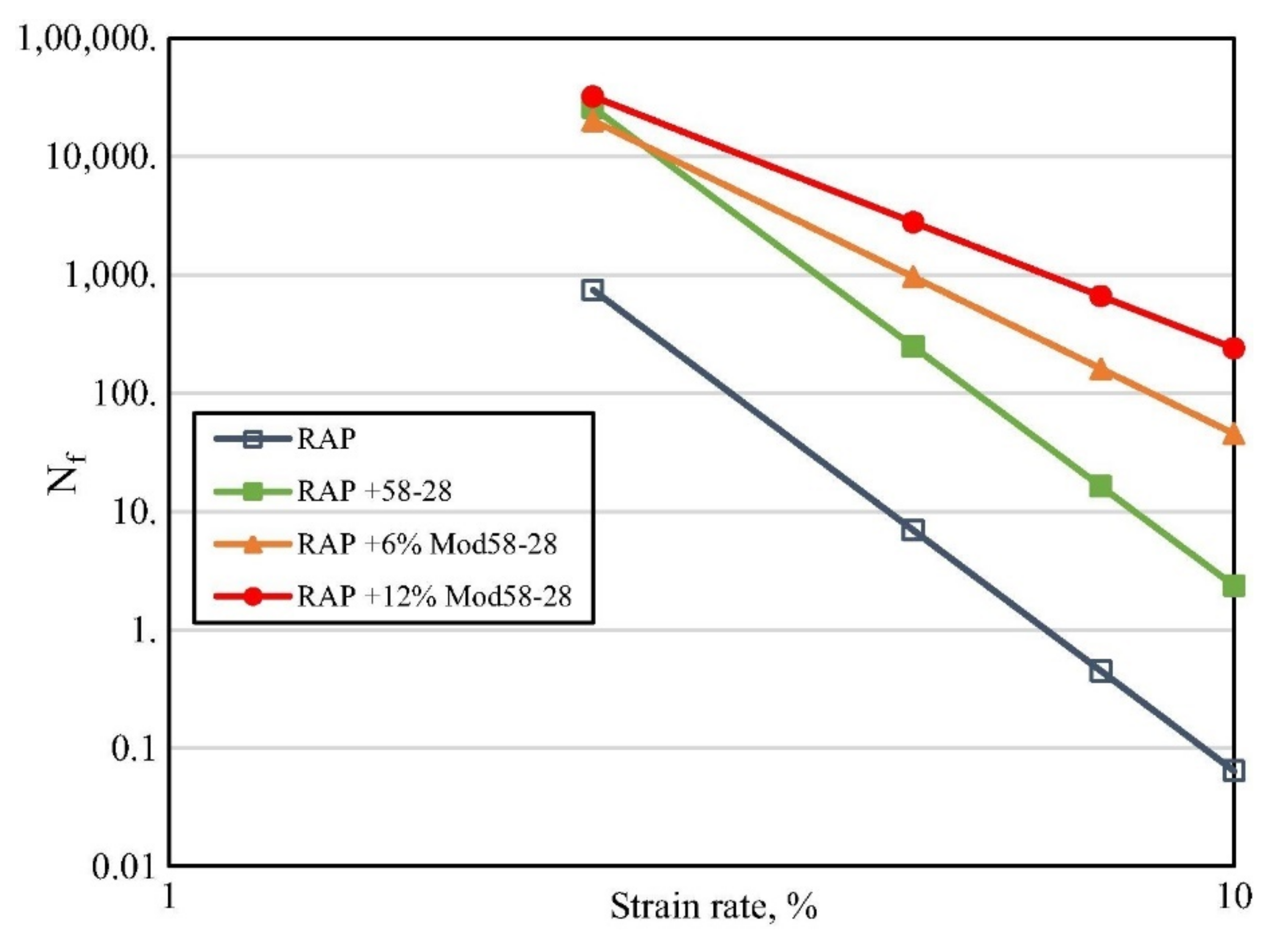
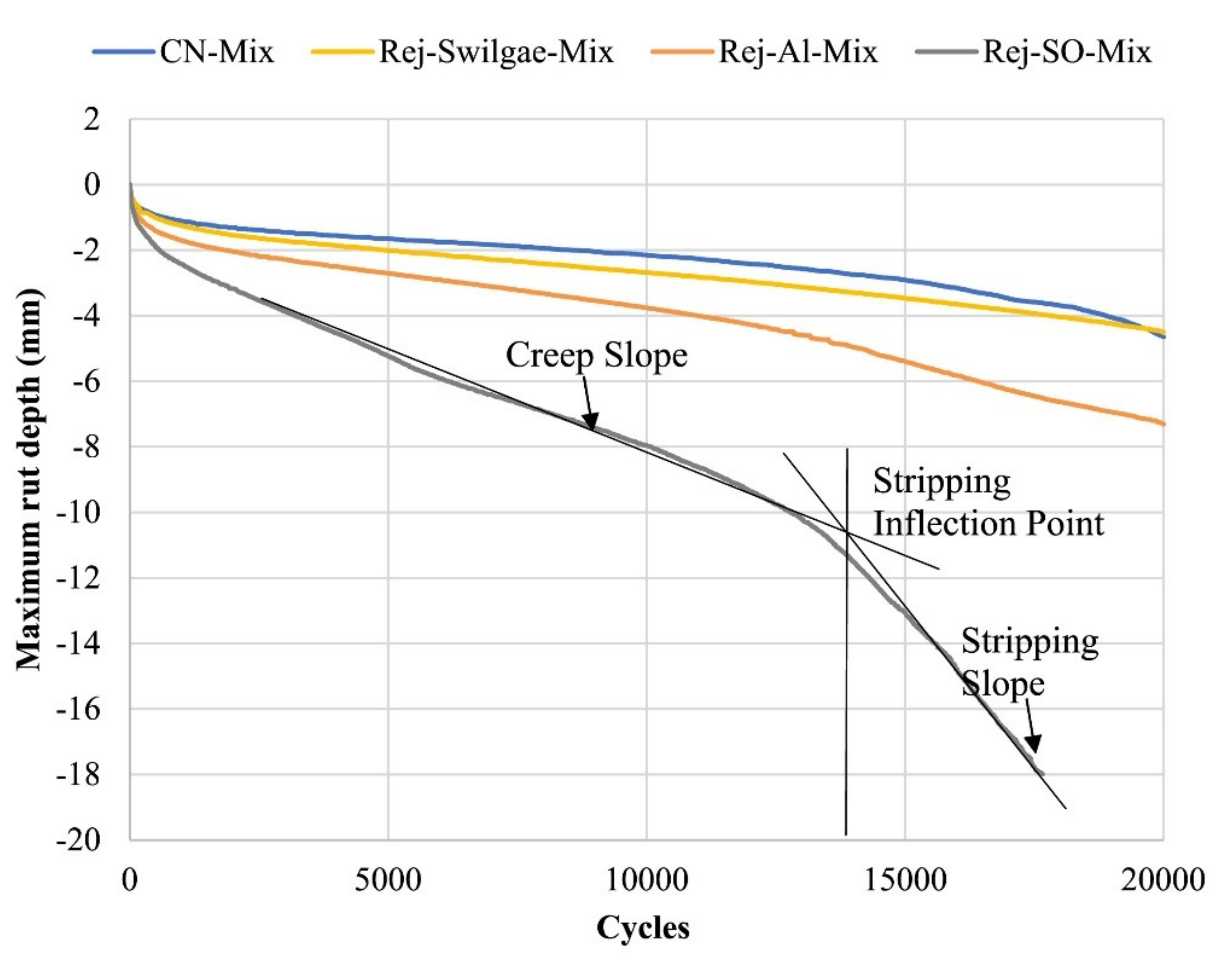
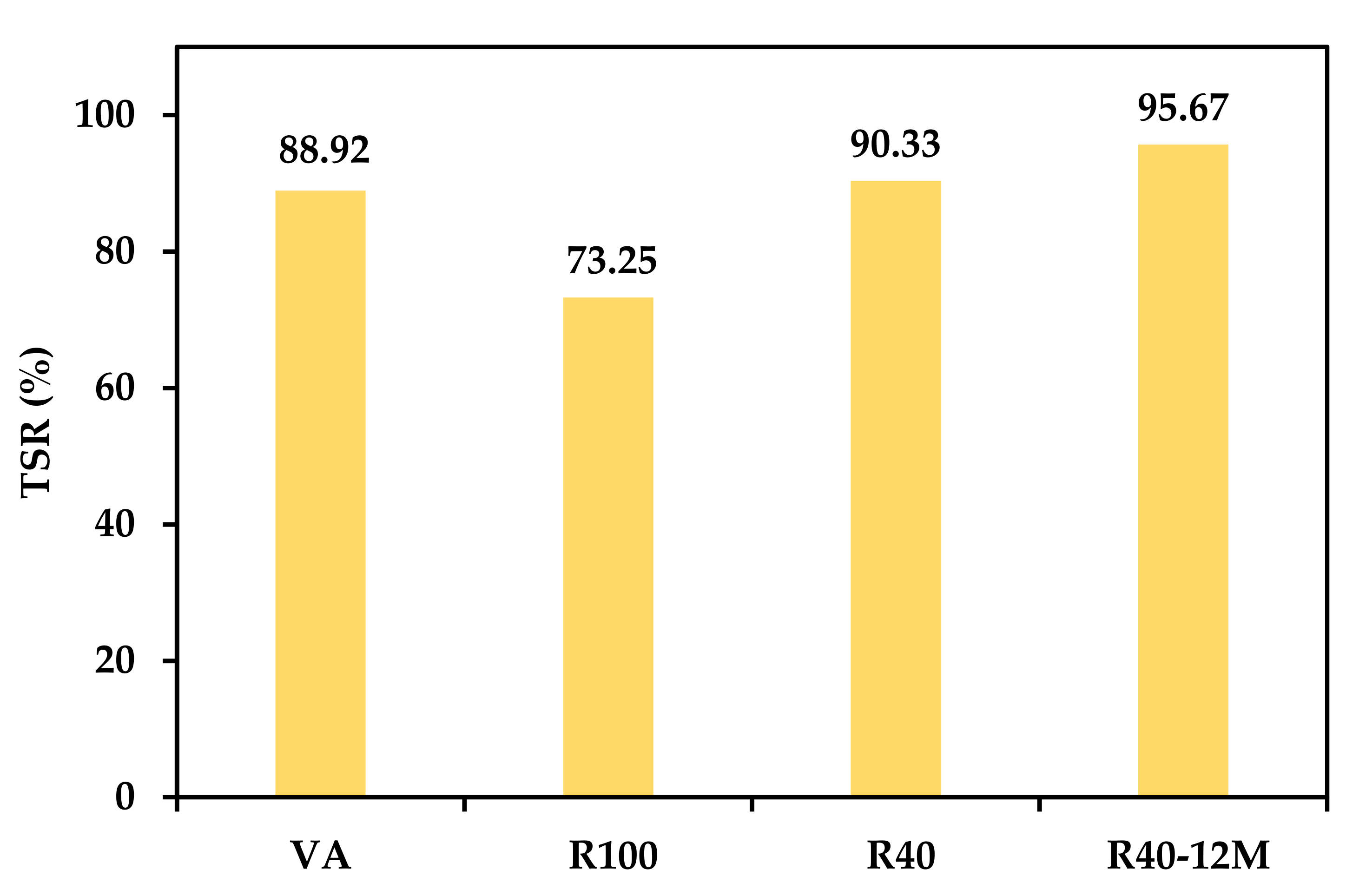
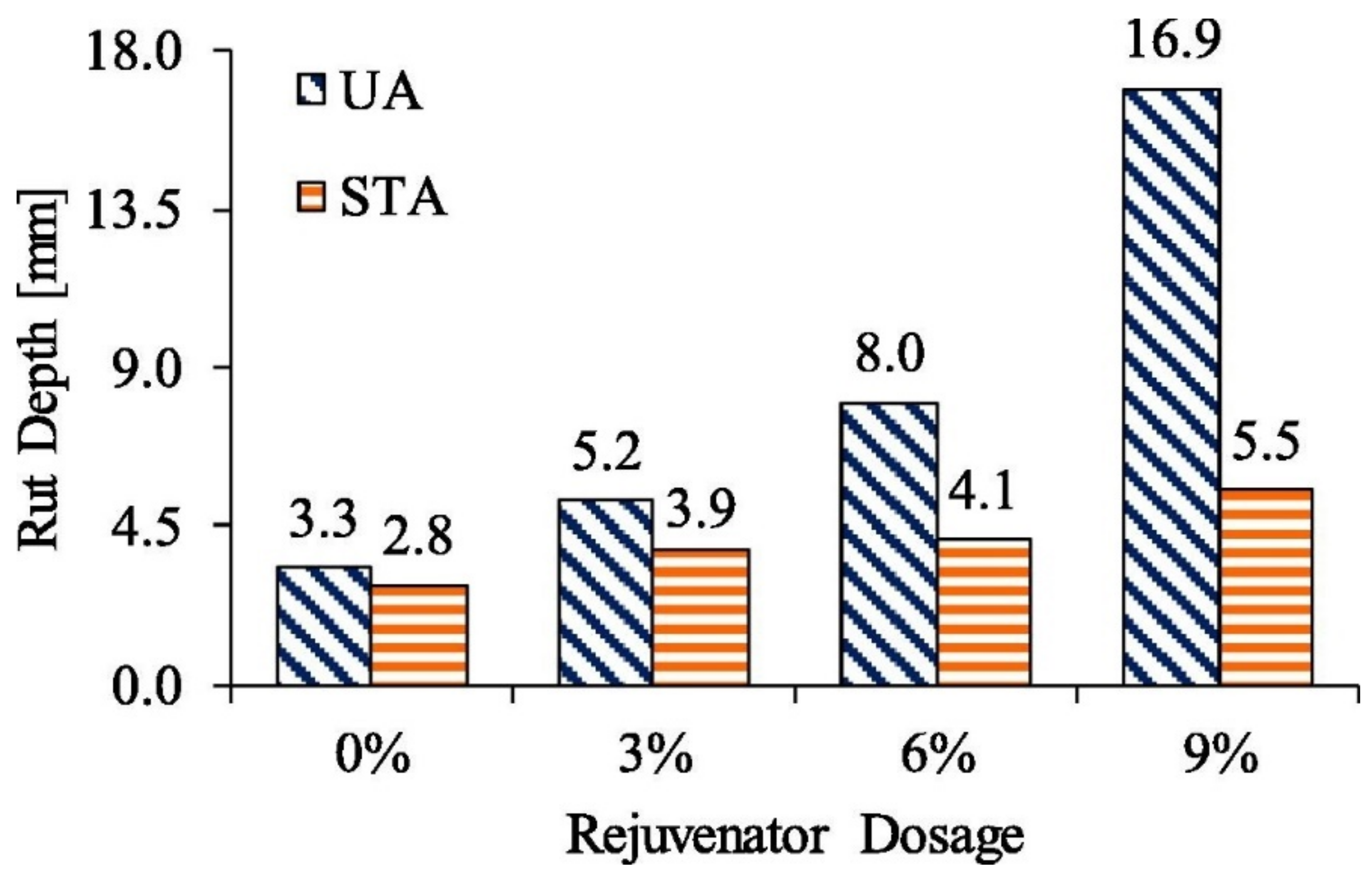

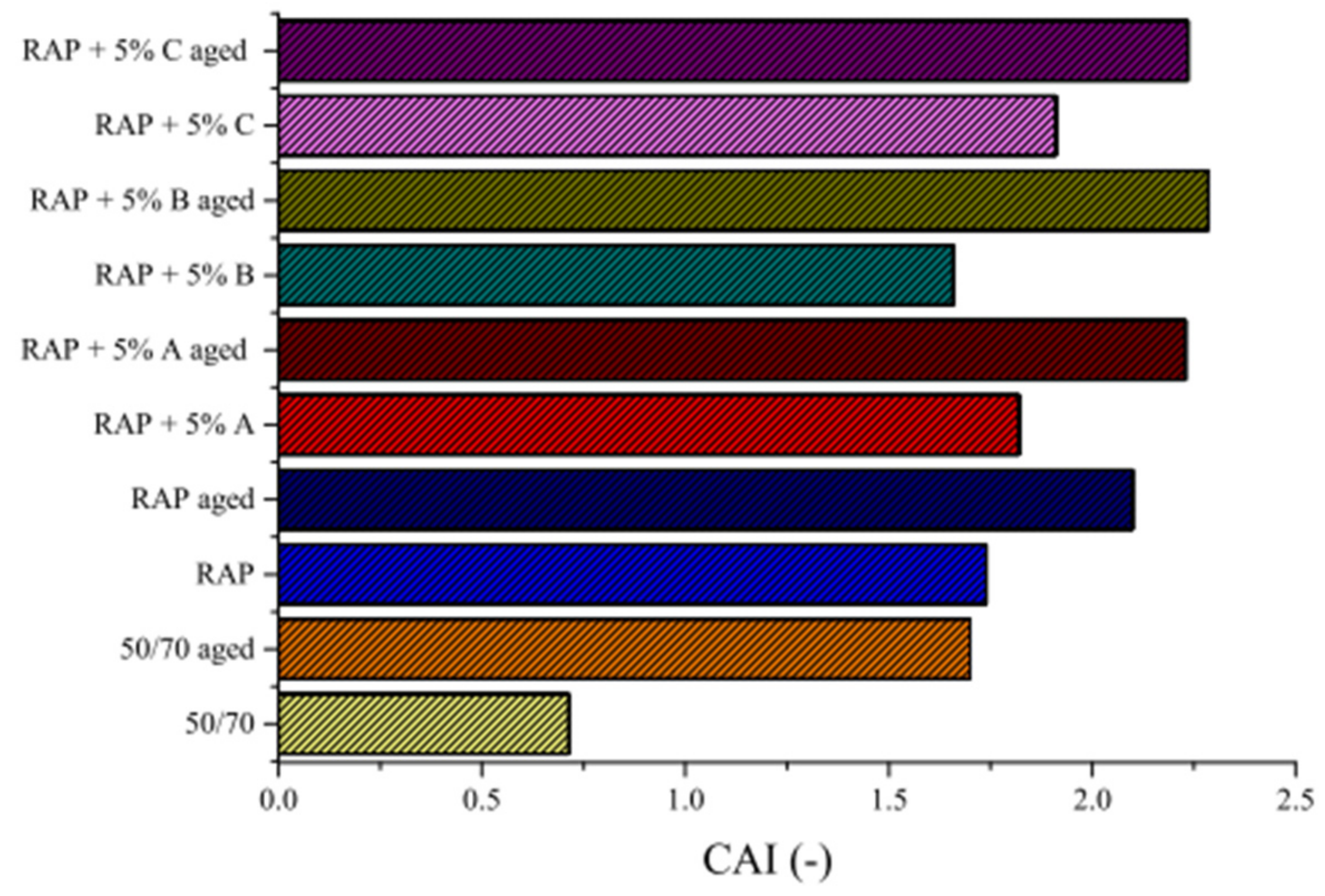
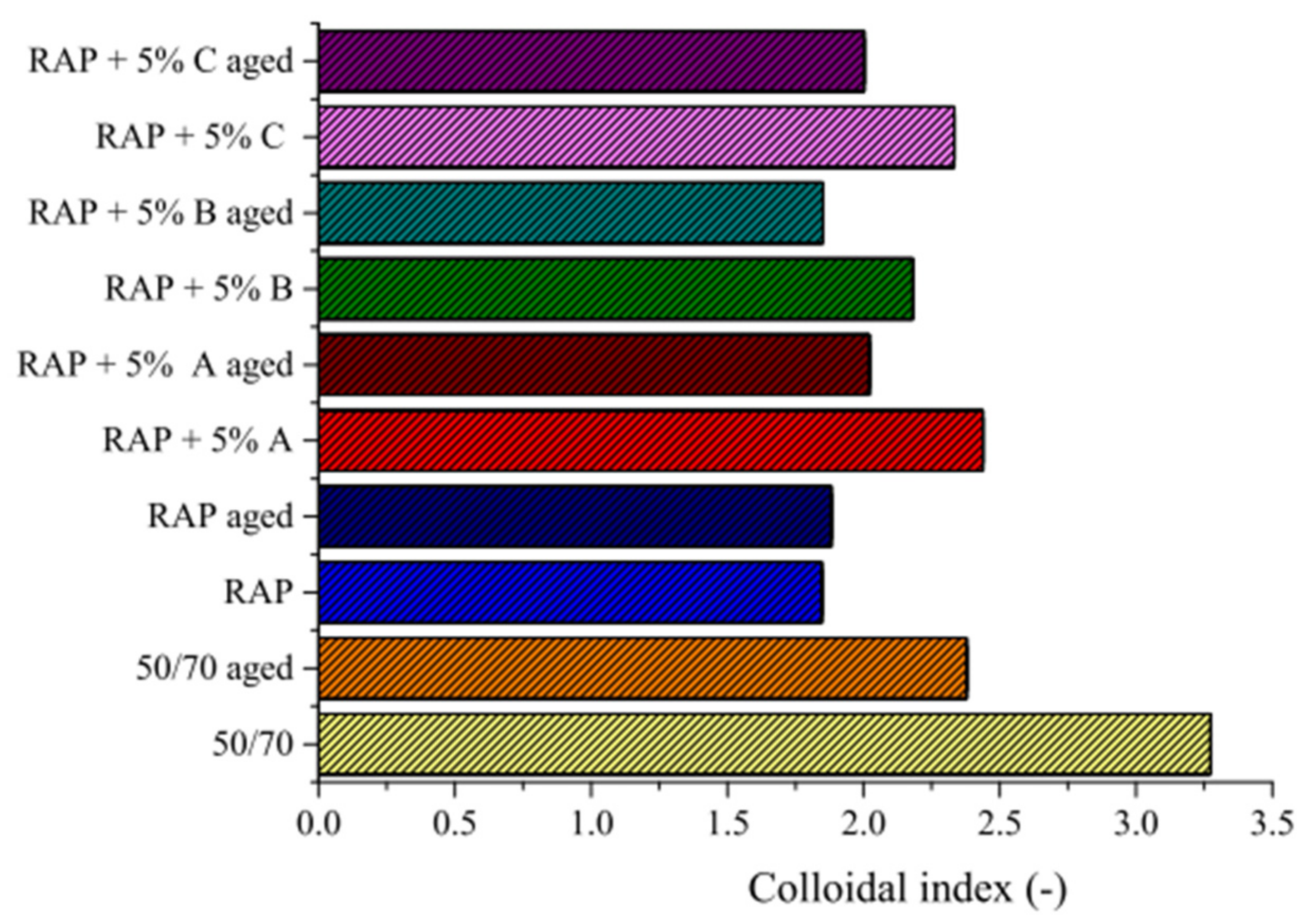
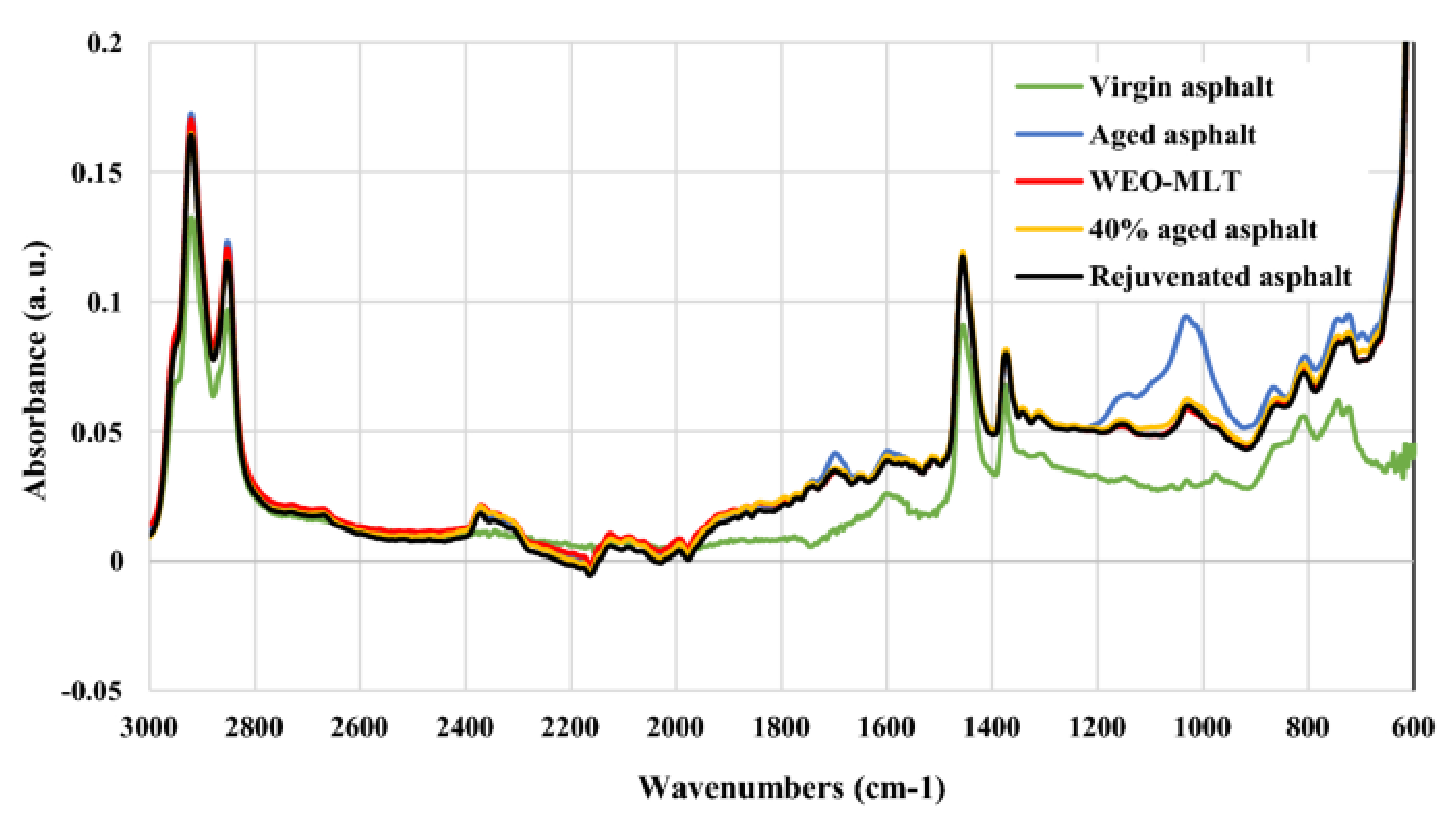
| Rejuvenators | Nature and Origin of the Product | Category | Risk Factors |
|---|---|---|---|
| Aromatic extracts and naphthenic oils | Specially produced by distillation of crude oil | Group 1 | N/A |
| Various recycled and treated oils and fats | Industrial activities (machine and engine oils) | Group 2 | In both groups, there are risks related to the hazardous emissions that have been built up in a previous life cycle phase. Furthermore, additional risks related to the existence of potentially mutagenic substances, heavy metals and carcinogenic. There are questions about thermal stability and possible odour nuisance. |
| Various recycled and treated oils and fats | Food industry | Group 3 | |
| Oils of biological origin (plant production) | Directly derived from plant production (agro-industry or forestry) | Group 4 | There are questions about the behaviour of materials at high temperatures (>150 °C up to 180 °C), more particularly about their thermal stability, flash point and related emissions and environmental odour nuisance. |
| Oils of biological origin (plant production) | Specially engineered for this purpose (by-products; engineered bio-based oils) | Group 5 | N/A |
| A residual category of specific products (flux oils, bio-oils from pyrolysis of biomass, etc.) | N/A | Group 6 | Doubts and concerns associated with their suitability as additive—especially those obtained from biomass pyrolysis, because that this technique gives rise to the existence of more hazardous materials such as PAHs. |
| Authors | Rejuvenator | Advantages | Drawbacks |
|---|---|---|---|
| Zargar et al. [43] | WCO | It can restore the penetration, softening point, and DSR characteristics. | |
| Zahoor et al. [8] | WCO | Rejuvenation process was influenced by acidity, WCO quality and water content. | |
| Hafeez [24] | WCO | Weak low-temperature fluid characteristics, oxidative degradation and vulnerability to hydrolysis in acidic medium. | |
| El-Shorbagy et al. [44] | WCO | 3–4% of rejuvenator had improved the moisture damage resistance. | |
| Zaumanis et al. [45] | WCO | 12% WCO had increased susceptibility to moisture damage and failed the minimum TSR requirement. | |
| Ziari et al. [6] | WCO | Rejuvenated asphalt mixtures containing WCO were very sensitive to moisture after ageing and exhibited poor resistance against ageing in terms of cracking and fatigue resistance. | |
| Chen et al. [2] | Waste edible vegetable | Both the rheological and physical properties of aged asphalts may be enhanced with optimum waste edible vegetable oil dosage. | Low thermos-stability, temperature flexibility, and elasticity of aged asphalts with waste edible vegetable oil demand further investigation. |
| Xinxin et al. [10] | Frying vegetable oil | Improved fatigue and low-temperature anti-cracking properties in aged asphalt, whilst restoring the penetration of aged asphalt. | Decreasing high-temperature rutting resistance. |
| Chen Meizhu et al. [2,48] | Plant oil | Improved the fatigue and low-temperature anti-cracking properties. | Poor ductility and performance at high temperature with higher dosages of rejuvenator. |
| Rajib et al. [25] | Plant extract and soybean oil | The rheological properties of aged asphalt were restored by all the assessed rejuvenating agents. | The plant extract displayed significant changes during shear-thinning moisture-induced evaluation, whilst the soybean oil was highly susceptible to moisture damage and terribly stripped during the HWTT. |
| Mirhosseini et al. [53] | DSO | Improved the fatigue life of the samples containing 20% and 30% RAP. | Rutting performance of the mixtures was deteriorated. |
| Azahar et al. [54] | WCO | Poor chemical, physical, and rheological properties at higher water content and acid value. |
| Rejuvenator | Agent Dosage (%) | Penetration @ 25 °C, (dmm) | Dose to Reach VA PEN. (%) | Visc. of Asphalt @ 135 °C (mm2/s) |
|---|---|---|---|---|
| Aged asphalt | 0 | 16.3 | - | 2054 |
| Asphalt PG 64-22 | 0 | 85.0 | - | 474 |
| Organic blend | 9 | 54.0 | 11.2 | 831 |
| Refined tallow | 9 | 83.7 | 9.7 | 612 |
| Paraffinic base oil | 18 | 91.3 | 18.3 | 379 |
| Aromatic extract | 18 | 95.0 | 18.3 | 406 |
| Naphthenic flux oil | 18 | 51.3 | ≥20 | 699 |
| WEO + FT wax | 18 | 28.0 | ≥20 | 1006 |
| WEO bottoms | 18 | 32.3 | ≥20 | 2054 |
| WEO | 18 | 87.7 | 18.2 | 457 |
| Distilled tall oil | 9 | 46.3 | 12.7 | 893 |
| Authors | Rejuvenator | Advantages | Drawbacks |
|---|---|---|---|
| Hussein et al. [55] | Maltene | Possibility of restoring the physical properties of very old-aged asphalt. | |
| Al-Saffar et al. [56] | Maltene | 8% and 16% of maltene managed to enhance the physical, rheological, chemical and mechanical properties of 30% and 50% of recycled asphalt. | |
| Al-Saffar et al. [57] | Maltene | The ageing effect of RAP asphalt was effectively mitigated by maltene. | |
| Wang et al. [59] | WEO | Increment of aromatic content in aged asphalt and enhanced the ductility attribute in the sample. | WEO-asphalt adhesion was enhanced with an anti-stripping agent, whilst the blend failed at high temperature. |
| Liu et al. [61] | WEO | Positive effects on fatigue behaviour. | Negative effects on asphalt rutting resistance. |
| Lin et al. [62] | WEO | WEO lowered cohesive strength at high temperature. | |
| Farooq et al. [63] | UMEO | Increased rejuvenator dose caused the ITS for both unconditioned and conditioned cases to reduce, whilst the TSR increased due to low fatigue resistance and adhesion level of RAP. | |
| Wang and Fang [59] | WEO | Good performance at low temperatures. | Anti-stripping agent was needed as WEO affected the aggregate-asphalt adhesion. |
| Ji et al. [68] | Heavy fuel oils | Easily volatilise at high recycling temperature. | |
| Xu et al. [69] | Aromatic extract | Displayed higher efficiency when used with asphalt (PG58-10) than with asphalt (PG58-28). | |
| Yin et al. [41] | Tall oil and aromatic extract | The rejuvenating agents were effective in partially reducing the stiffness and restoring the properties of aged asphalt. | Their efficacy deteriorated with ageing. |
| Espinoza-Luque et al. [71] | Aromatic oil | The effect on rutting was very pronounced at a high dosage. |
| Components | PAV-Aged Asphalt | 5% Rejuvenated Asphalt | 10% Rejuvenated Asphalt |
|---|---|---|---|
| Asphaltenes | 19.3053 | 16.9243 | 13.6467 |
| Saturates | 15.0278 | 14.8938 | 17.0068 |
| Aromatics | 32.9004 | 33.8075 | 31.946 |
| Resins | 32.7664 | 34.3744 | 37.4005 |
| Authors | Rejuvenator | Advantages | Drawbacks |
|---|---|---|---|
| Zhang et al. [74] | Waste wood bio-oil | Improved both the rutting resistance and fatigue life of the aged asphalt. | |
| Zhang et al. [75] | Sawdust-derived bio-oil | The rejuvenator softened and restored the properties of the samples. | Carbonyl (C=O) index increased with the addition of more than 10% of bio-oil. |
| Kowalski et al. [76] | Rapeseed oil | Decreased the viscosity of sample and changed its properties at low temperature. | Viscosity increased and the properties of the rejuvenated asphalt at high temperature. |
| Cao et al. [46] | Soybean oil by-product | Reduced the sulfoxide index. | High W-oil content increased the carbonyl index, as W-oil mostly contained fatty acid with high carbonyl (C=O) content. |
| Zhu et al. [77] | Bio-binder (cotton oil) | Decreased the carbonyl and sulfoxide indices of the PAV-aged asphalt. | It cannot be used to restore the low-temperature properties of the aged asphalt to its original level at –18 °C and –24 °C. |
| Cavalli et al. [81] | Natural seed oil (A), cashew nut shell oil (B), and tall oil (C) | Prior to ageing, rejuvenators B and C demonstrated higher potential of softening the aged asphalt than A. Upon being subjected to ageing, the rheological characteristics of the rejuvenated samples were affected the most. | -The rheological properties of the samples were highly affected by ageing -Both RAP+C and RAP+A exhibited higher absorbance at wavenumber linked to carbonyl index than aged asphalt. |
| Nayak and Sahoo [82] | Pongamia oil | Incorporation of rejuvenating agent softened the aged asphalt without breaking the chemical bonds at the molecular level. |
Publisher’s Note: MDPI stays neutral with regard to jurisdictional claims in published maps and institutional affiliations. |
© 2021 by the authors. Licensee MDPI, Basel, Switzerland. This article is an open access article distributed under the terms and conditions of the Creative Commons Attribution (CC BY) license (https://creativecommons.org/licenses/by/4.0/).
Share and Cite
Al-Saffar, Z.H.; Yaacob, H.; Katman, H.Y.; Mohd Satar, M.K.I.; Bilema, M.; Putra Jaya, R.; Eltwati, A.S.; Radeef, H.R. A Review on the Durability of Recycled Asphalt Mixtures Embraced with Rejuvenators. Sustainability 2021, 13, 8970. https://doi.org/10.3390/su13168970
Al-Saffar ZH, Yaacob H, Katman HY, Mohd Satar MKI, Bilema M, Putra Jaya R, Eltwati AS, Radeef HR. A Review on the Durability of Recycled Asphalt Mixtures Embraced with Rejuvenators. Sustainability. 2021; 13(16):8970. https://doi.org/10.3390/su13168970
Chicago/Turabian StyleAl-Saffar, Zaid Hazim, Haryati Yaacob, Herda Yati Katman, Mohd Khairul Idham Mohd Satar, Munder Bilema, Ramadhansyah Putra Jaya, Ahmed Salama Eltwati, and Hassanain Radhi Radeef. 2021. "A Review on the Durability of Recycled Asphalt Mixtures Embraced with Rejuvenators" Sustainability 13, no. 16: 8970. https://doi.org/10.3390/su13168970
APA StyleAl-Saffar, Z. H., Yaacob, H., Katman, H. Y., Mohd Satar, M. K. I., Bilema, M., Putra Jaya, R., Eltwati, A. S., & Radeef, H. R. (2021). A Review on the Durability of Recycled Asphalt Mixtures Embraced with Rejuvenators. Sustainability, 13(16), 8970. https://doi.org/10.3390/su13168970









